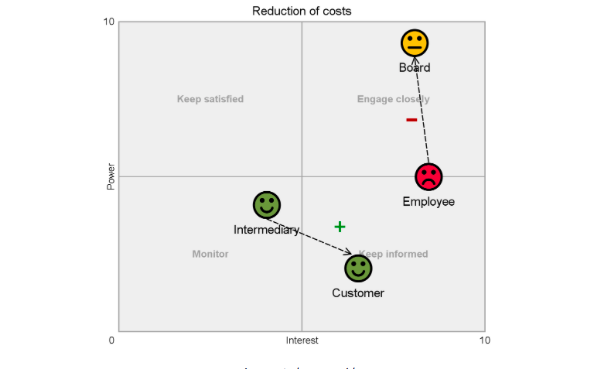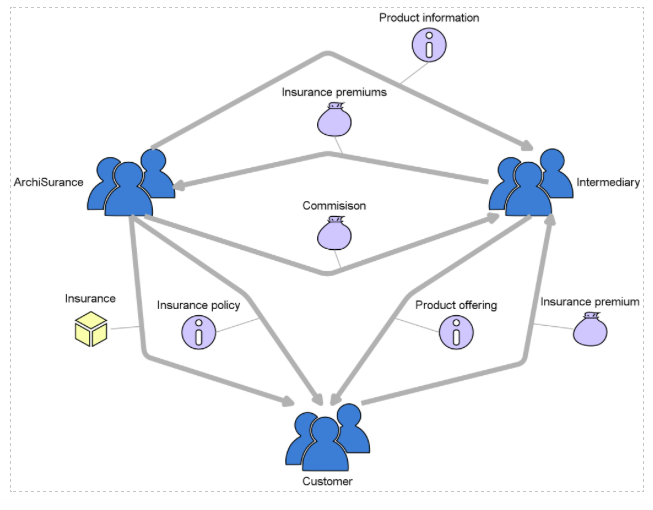Everyone remotely involved with enterprise architecture and similar disciplines knows the importance of knowing your stakeholders. Stakeholder management is a key technique in EA and many methods, including TOGAF, stress its importance. But there is more to management than keeping individual stakeholders happy. In this blog post, I want to introduce three techniques that not only help you ensure stakeholder satisfaction, but also make good use of stakeholders and their influence in achieving business goals.
The first technique I want to discuss is the augmented power grid, which is slightly different than the classical power grid familiar to many architects. The version described by TOGAF’s Chapter 21 on stakeholder management plots the level of interest against the power of stakeholders, and then identifies how to address stakeholders in the following four quadrants (shown in picture below):
Based on this analysis, you can then define a communications strategy with specific engagement deliverables for different stakeholder groups.
In Enterprise Studio, we support an augmented version of this power grid, pictured below. We have added two things to the standard power grid:
In the example below from an insurance company, we see that employees are not happy with the cost reduction goal and may exert a negative influence on the Board, which itself is currently indifferent. Intermediaries and customers are both positive about this cost reduction, though, as intermediaries influence their customers and their choice for certain products. This is a crucial relationship in the business model of this insurance company.

Knowing about these relationships is key in understanding company politics, as well. Moreover, it helps you influence stakeholders who are out of your direct reach by targeting others whom you can address directly. But be aware that this can be sensitive knowledge.
Next to knowing who your stakeholders are, you also have to understand their concerns or drivers. You can then assess the current situation with respect to these drivers and, based on those assessments, define change goals and desired (and undesired) business outcomes. To realize these goals, you need to understand key business capabilities and which resources are needed. The implementation of these goals is then modeled as the core of your architecture. Change initiatives, in turn, can be related to these architecture elements.
All of this can be expressed in the ArchiMate modeling language, as supported by Enterprise Studio:
Together, this gives you full traceability from investments in projects and programs, via the capabilities you develop or improve, to the business outcomes you realize and the stakeholders you serve. This traceability is key in informed decision-making on investment priorities. Too often I see ‘decibel-driven’ project portfolio management, where the loudest voices get their projects approved, whereas less vocal stakeholders are left in the cold.
Enterprises are part of increasingly complex webs of customers, suppliers, partners, regulators, shareholders and various other parties. All of these should be treated as stakeholders. To gain more insight into these webs, ecosystem models can be helpful. Rather than putting your own enterprise at the center and only looking at the relationships it has with others, an ecosystem model looks at the broader perspective and also encompasses relationships between other stakeholders.
Knowledge about these relationships helps you, much like the augmented power grid. Moreover, you can take an economic perspective and model the value creation and distribution within such an ecosystem, looking at the value contribution of different parties and analyzing the effects of change to the parties involved within that ecosystem.
The figure below shows a very simple, three-party ecosystem model for the well-known insurance company, ArchiSurance, with various flows of information, products and money. As you can see, it also shows the relationships between customers and intermediaries, something that is outside the boundaries of your own organization but crucial to understanding your value network. Previously, we already saw how intermediaries influence their customers, another relevant type of relation that we might also add to this figure.

The three techniques shown here are, of course, fully supported by Enterprise Studio, and tie in to many other types of analysis and visualization. For example, zooming in on such an ecosystem model, you might want to create Business Outcome Journey Maps that provide more detail on the value creation, or Customer Journey Maps that help you understand and improve the customer experience.
The underlying, integrated models provide you with a powerful instrument to address your stakeholders’ needs. Rather than basing management decisions on hope and gut feeling, these models provide solid ground for decision-making and help you address your stakeholders in a balanced, fact-based manner.
Do you want to know more about these and other techniques? Don’t hesitate to contact us!